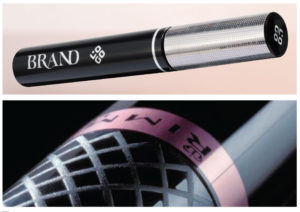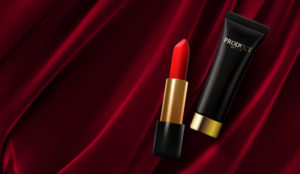by Brittany Willes, editor, Plastics Decorating

Prominent fashion designer Yves Saint-Laurent was reported to have said, “The most beautiful makeup of a woman is passion, but cosmetics are easier to buy.” This is true in part due to the number of brands and products available today. In an oversaturated market, brands have precious little time to attract and keep consumers’ ever-dwindling attention long enough to ensure purchase. As a result, packaging has a vital role to play when it comes to making individual products stand out. Cosmetics packaging, in particular, has become a highly competitive arena, and the demand for luxury packaging at an affordable price is expected to continue to rise in the years to come.
A growing market

“Cosmetic Packaging Market – Growth, Trends and Forecasts (2019-2024),” a recent report published by Research and Markets, determined that the global cosmetic packaging market in 2018 was valued at $27.87 billion (US). By 2024 that number was expected to reach roughly $35.7 billion (US) with a CAGR of 4.3% over the forecast period (2019-2024).
“The market studied is mainly dependent on the global cosmetic products market and is subjected to similar dynamics. The increasing demand for cosmetic products in emerging countries and growing consumer awareness are driving the investments of companies that develop innovative packaging solutions. Therefore, a rise in the demand for cosmetic products is expected to boost the demand for packaging,” the report stated.
The emphasis on innovative packaging solutions is no surprise to those in the trenches. Material suppliers, decorators, designers and manufacturers have been experiencing first-hand the need for more dynamic packaging as a means of setting products apart from those offered by competitors. With consumer demands expected to increase in 2019, cosmetics manufacturers are looking to consumers to determine the best ways to make their products stand out.
Interpack Processing and Packaging’s recent study, “Packaging Trends for Cosmetics 2019: Sustainability Combined with Luxury,” found an emerging emphasis on packaging that combines both luxury and sustainability.
According to Interpack, “The market research and forecasts conducted by beauty product manufacturers are suggesting that consumers are especially looking for luxury and glamour on their cosmetic packaging this year. But the packaging also needs to be as multi-functional and sustainable as possible, while being easy to handle and to transport. For the industry, this means producing small quantities in record time and as cheaply as possible, while not forgoing luxury and sustainability.”
Revitalizing a classic look
“Consumers expect high-end finishes and designs that convey luxury and quality,” stated Allan Quimby, marketing manager for KURZ Transfer Products. Specializing in thin film technology, the Charlotte, North Carolina-based manufacturer develops decorative and functional coatings for a variety of products, including foil for cosmetics packaging.
“Metallic finishes are the norm for the cosmetics industry,” Quimby continued. “They are an expectation and requirement for successful product launches and for upholding the image that many brands have worked so hard to build. These foil finishes have been – and continue to be – popular not only with the larger brands but with the smaller and mid-sized brands as well.”
Part of what makes foil such a popular choice for cosmetics is the classic look it gives the packaging. Gold foil, especially, is what most consumers think of when picturing some of their favorite cosmetics: a simple effect that conveys a touch of elegance and luxury that most brands strive for.
“Metallic foils do continue to be the standard look for so many classic cosmetic packages, such as Chanel, Lancôme, Estee Lauder, Clinique, Revlon or L’Oréal,” affirmed Bill Morey, manager, technical sales, hot stamp dies and tooling for Schwerdtle, Inc.
Headquartered in Bridgeport, Connecticut, the die and tooling supplier works with many product decorating companies looking to differentiate their products. As a result, Morey has seen that it is not just large name brands that benefit from the classic look of foil. “Simple applications of bright gold or silver foils can allow private label cosmetic packaging to stand out as well,” he noted.
 While classic gold and silver hot stamp foils will continue to be popular choices, hot stamping foils and specialty effects have been evolving to better serve the growing industry. Morey stated that one of the emerging trends in the last few years has been with multicolor foil effects. For plastic as well as glass containers, more and more designers are opting to use multicolor effects. According to Morey, a package might start with a fully metallized container that is then screen printed and hot stamped in any combination of pigments and bright metallics.
While classic gold and silver hot stamp foils will continue to be popular choices, hot stamping foils and specialty effects have been evolving to better serve the growing industry. Morey stated that one of the emerging trends in the last few years has been with multicolor foil effects. For plastic as well as glass containers, more and more designers are opting to use multicolor effects. According to Morey, a package might start with a fully metallized container that is then screen printed and hot stamped in any combination of pigments and bright metallics.
“Another striking effect can be to subtly mix spray color coatings as a base and then coat over it with bold inks and foils. For example, a lot of eyecare packaging utilizes multiple color designs on brightly colored, molded packages that may then be hot stamped using shiny, metallic-base pigmented foil, such as black, that will complement with bright gold, silver or even a different metallic pigment color foil in a two-color package,” said Morey.
Innovations with foil
Just as packaging itself has evolved over time, so too have the effects and decoration process itself. To meet customer needs, foil stamping has had to adapt itself to become more user friendly. Quimby noted how decorators today have an ever-widening variety of improved application equipment to meet these growing needs.
As a result, there are many economical features that make foils more affordable, even for smaller brands looking to establish shelf presence. According to Quimby, KURZ has developed processes and products to be competitively priced in the commodity space.
“We find that most designers and engineers are already very familiar with foils and how to use them. They are often hungry for new innovations and technologies to take their packaging to the next level,” he said.
Incorporating metallic finishes into packaging designs is essential for giving brands and products the luxury and high-quality image that influences many consumers’ purchasing decisions.
In order to best take advantage of the latest innovations and ensure the final product appeals to consumers, a great deal of collaboration must take place. “I have long advocated for early collaboration between the concept designers, art houses, package engineers, molders and decoration tool suppliers to work together to ensure a smooth product launch offering superior product appearance and functionality,” said Morey.
Along with providing the classic, luxury image consumers expect, further innovations with metallic finishes are now available, particularly personalization. “We are seeing the constant need for personalization and digital connection/enhanced user experience for the consumer,” remarked Quimby. Part of living in the digital age means increased need for incorporating digital elements even into product packaging.
Elements such as QR codes are able to connect consumers directly to product manufacturers, allowing for a highly personalized consumer experience. These elements have their own role to play in packaging design.
“I think we can all agree that this trend crosses into most industry requirements,” Quimby continued. “KURZ has invested ahead of this trend, and today we are able to offer and deliver many new technologies – such as DIGITALMETAL® – application equipment and even customized software solutions to engage, meet and exceed these requirements for both the brand owner and consumer.”
Current and future trends
As predicted by Interpack, one of the fastest growing trends in cosmetics packaging is sustainability. Market research noted how “one major aspect for many shoppers is not just luxury, but also sustainability; and the packaging needs to be just as natural as the ingredients contained within the beauty product. High up on the wish list is refillable and recyclable packaging made of environmentally friendly materials. But that doesn’t mean doing without an air of luxury: transparent cellophane made of biodegradable wood pulp, for instance, can add some shiny metallic glamour to the packaging.”
Companies like KURZ have been working hard to balance the need for luxury and the desire for sustainable packaging to meet customer demands.
“A large growing trend for KURZ is the replacement of less environmentally friendly metallic effects with hot and cold stamping foils,” said Quimby. “We feel that this trend will continue to drive business back to the US over the next few years, because many brand owners want to reduce their carbon footprint.”
The push for sustainable packaging isn’t the only trend drawing business back to the US, according to Quimby. “We’ve been seeing a number of projects coming back to the US for a number of reasons,” he stated. “Some brands want to control the manufacturing and supply chain process better. Counterfeiting continues to be a major obstacle and issue for a lot of brands.”
Anti-counterfeiting, brand protection and enhancement solutions continue to be major focuses for all brand owners as more and more counterfeit products flood the market. “The damage that can be caused by counterfeiters is immeasurable for a brand,” said Quimby.
Other trends include the possibility of production in smaller lot/run sizes and wanting to manage the inventory, waste and cost more closely. “Some are doing it strictly for cost savings resulting from higher importation, logistic and manufacturing costs,” Quimby said.
Morey said Schwerdtle has likewise noticed an increase in work returning to the US.
“American molders were already getting more efficient with new and faster molding presses integrating more automation, which, in turn, allows them to produce more finished goods without greatly increasing the in-house production employment numbers,” he said. “However, if we see our customers increasing their decorating die supply orders to us, it means they are producing more goods that, in turn, will have to ship. This could potentially lead to increased employment levels, right from the package engineering departments to molding, decorating, assembly, then packaging and shipping. Overall plant and machine maintenance would be necessary as well – all requiring additional work hours – if not added personnel.”
Whether through a desire to decrease carbon footprint through more sustainable packaging materials, desire for increased brand protection or more efficient processes – no matter the reason – more jobs moving back to the US is a trend most hope to see continue.
Looking ahead
It’s clear that no matter the design or current trend, hot stamping foils will always have their place in cosmetics packaging. They will always convey a feel of elegance and luxury that consumers associate with skincare and makeup products.
Whether through a classic gold foil or a more modern punk purple metallic finish, hot stamping for cosmetics is a sustainable solution in which companies and consumers are happy to invest.


